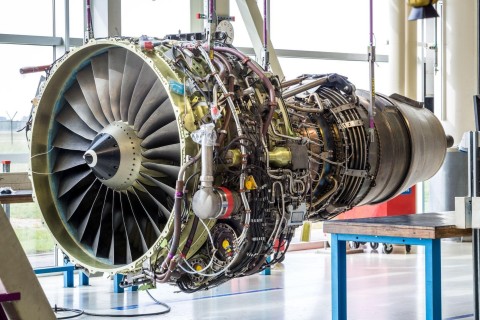Optomec Delivers $1 Million Metal Additive System for Production Repair of Turbines
Optomec announced the delivery of a multi-functional Additive Manufacturing (AM) machine to a leading supplier to the $37 billion worldwide aviation engine Maintenance Repair and Overhaul (MRO) market. The user is an existing customer with more than 5 Optomec Metal Additive systems being used in production to repair a range of turbine components from aircraft engines, as well as industrial gas turbines. The new machine combines two turbine repair process operations that are typically done manually, not only reducing the cost of engine overhauls, but also improving the quality and consistency of these flight-critical procedures.
This press release features multimedia. View the full release here: https://www.businesswire.com/news/home/20211014006080/en/

Gas engine undergoing overhaul at an MRO facility. (Photo: Business Wire)
Optomec’s proprietary process uses a combination of advanced machine vision, adaptive software, on-the-fly laser power adjustment and automation to precisely add metal to worn engine components, restoring them to the geometric specifications set by the original turbine engine manufacturers.
Optomec’s Metal Additive repair solutions are the gold standard in the gas turbine industry and are currently used in high volume production in approximately 100 MRO installations worldwide. A single machine has the capacity to repair 10,000s of turbine blades annually, and together Optomec users having performed production repairs on more than 10 million components over time. The global fleet of 25,000 commercial aircraft and 50,000 military aircraft have a mandated time between overhaul (TBO) of around 5,000 flight hours, creating a large and growing demand for automated repair equipment. Optomec Additive Manufacturing systems are currently certified for aviation repair in 15 countries.
“There are really three advantages to using the Optomec AM process for repairing turbine components,” said Jamie Hanson, Optomec’s VP of Business Development. “First of all, it saves time and cost relative to manual repairs. Secondly, it requires far less heat input, so the base metal is far less affected by the repair. Finally, because the adaptive AM process adds less repair metal, the downstream machining costs are drastically reduced.”
Optomec’s Metal Additive Manufacturing machines use a process called Directed Energy Deposition (DED) to build 3D metal parts by deposing powdered metal into a precisely controlled pool of melted metal. Fiberoptic lasers supply the thermal power while advanced motion control systems produce the required geometries for the parts. Optomec leads the DED market with more than 200 DED machines in use.
Optomec is a privately-held, rapidly growing supplier of Additive Manufacturing systems. Optomec’s patented Aerosol Jet Systems for printed electronics, and LENS and Huffman brand 3D Printers for metal component production and repair, are used by industry to reduce product cost and improve performance. Together, these unique printing solutions work with the broadest spectrum of functional materials, ranging from electronic inks to structural metals and even biological matter. Optomec has delivered more than 500 of its proprietary Additive Manufacturing systems to more than 200 marquee customers around the world, for production applications in the electronics, energy, life sciences and aerospace industries. Our users include countless blue-chip manufacturing companies, such as GE, Samsung, Raytheon, Siemens, Lockheed and LiteOn, as well as the US Air Force, US Navy, US Army and NASA. For more information, visit optomec.com.
LENS is a registered trademark of Sandia National Labs; Aerosol Jet is a registered trademark of Optomec, Inc.
View source version on businesswire.com: https://www.businesswire.com/news/home/20211014006080/en/




